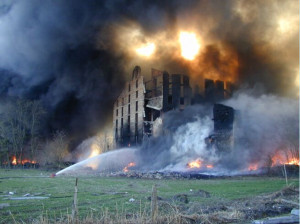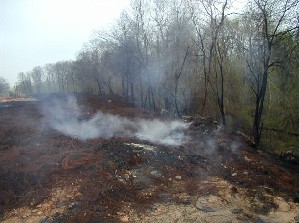Around 9:50 am, fire burned through a stockpile of 5 million tyres, spreading to an 8-storey building also used as a warehouse. Thick black smoke was visible 40 km away. Six dwellings were evacuated and 35 individuals housed elsewhere. A safety perimeter was set up and a departmental highway closed to traffic. Fire-fighters prevented the fire from spreading to nearby dwellings and had it contained within 24 hours. The blaze was still smouldering 3 weeks later. It was anticipated to deposit earth on all ignited debris as well as at the base of the heap at the property boundary containing an indefinite volume of tyres. Air quality analyses revealed that pollution reached a maximum on 6th February around 6 am before dipping at 1 pm. The concentrations of CO, SO2 and toluene were below alarm thresholds, while measured benzene values were below the most stringent recommendations. Dust content exceeded 500 µg/m³ in the smoke plume on the morning of the 6th prior to dropping below the recommended WHO level (80 µg/m³ as a daily average value). This same day, 3 water samples extracted at the site, both before and after discharge into the ARCON River, indicated an absence of pollution. Smoke releases were still visible 9 months later. Definitive extinction was made possible by removing the incandescent residue and soaking it in a skip filled with water, in an action lasting 24 days. This abandoned depot was under classified facilities jurisdiction, yet no administrative procedure had been initiated. The operator had filed for bankruptcy in September 1999. This accident was caused by an arsonist (who would be arrested on 28th May). A Prefectural order prescribed emergency works: site watchman and installation of a fence, plus the monitoring of environmental impacts, followed by site clean-up through removal of burned debris and building demolition. The cost of site rehabilitation amounted to €1 million, with demolition being completed in January 2005. To compensate for the owner’s default, the Prefect obtained European subsidies (50%), with remaining funds being raised by the ADEME Environmental Agency. The same actors were involved in site restoration: creation of a honeycombed cell for storing residue, creation of a public utility right-of-way, and monitoring of leachates produced by the cell for 5 years. The slag soaked in the skip was transferred to a Class 1 waste storage centre.
Download the detailed report in .pdf format (489 Kb)






